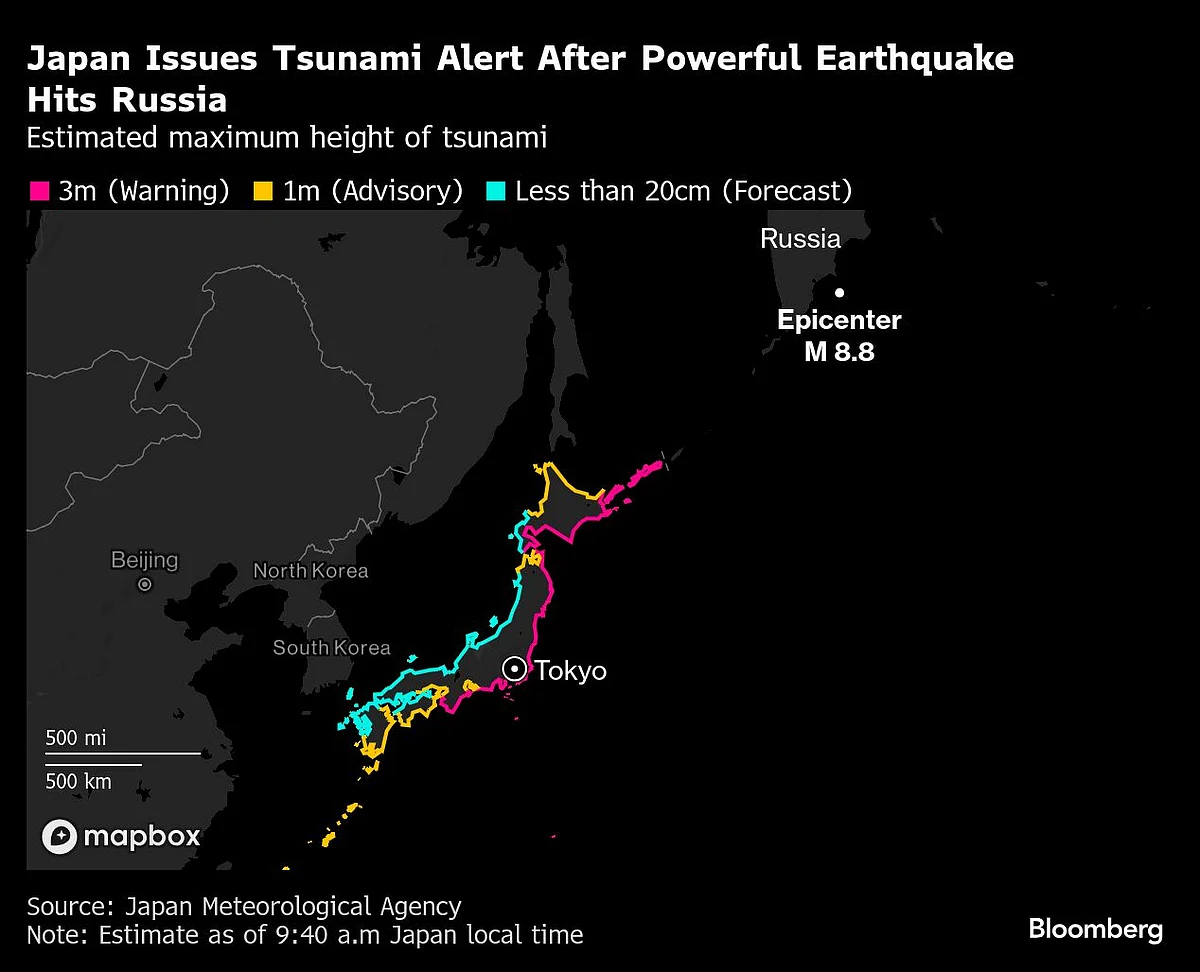Tsunami Reaches US As Powerful Quake Puts Pacific On Alert
While some alerts in Hawaii were downgraded to advisories — allowing evacuees to return home — and warnings in Shanghai were canceled

Four-foot (1.2-meter) waves were recorded in Hawaii and the initial signs of a tsunami were detected in California after a powerful earthquake in Russia’s Far East triggered alerts across the Pacific.
While some alerts in Hawaii were downgraded to advisories — allowing evacuees to return home — and warnings in Shanghai were canceled, authorities remained watchful.
“Everything has been OK so far, we haven’t seen a big wave,” said Hawaii Governor Josh Green. Water was seen receding from the coastline, which can be a sign of an imminent tsunami, and “we expect two to three hours at least until we can call all clear,” he said.
A magnitude-8.8 quake struck at a depth of 21 kilometers off Russia’s Kamchatka Peninsula on Wednesday morning local time, triggering tsunami alerts from Japan and China to the US and Canada, and as far away as Indonesia and New Zealand. An earthquake of that scale marks the strongest worldwide since 2011, according to recent data from the US Geological Survey, and the most powerful in Russia since 1952.
Wednesday’s quake likely came from a shallow undersea “mega-fault,” said Rebecca Bell, a professor of tectonics at Imperial College London. “These are the largest faults on Earth and are capable of hosting the largest earthquakes,” she said.
Japan has seen minimal impact so far. Several 30-centimeter waves were detected across the country, including the northernmost region of Hokkaido, according to the US National Oceanic and Atmospheric Administration. Another 10cm wave was seen in Kanagawa prefecture, Japanese authorities said.
Prime Minister Shigeru Ishiba urged residents in affected areas to evacuate. “It’s possible that the second, third and fourth waves of tsunami could be much bigger” than the first, he said. He asked people to remain vigilant until the warning is lifted, which could take another day.

Japan is no stranger to tsunamis. In 2011, it was hit by a magnitude-9 quake off the northeastern coast, triggering waves of nearly 40 meters that destroyed coastal cities and claimed more than 20,000 lives. The waves overwhelmed Tokyo Electric Power Co.’s nuclear power plant in Fukushima, which resulted in a power failure and subsequent meltdown at the plant.
On Wednesday, NHK switched from normal programming to show information about the warning and urged people to flee from the shore. The broadcaster showed cars heading away from coastal areas in Matsushima in Miyagi prefecture, northern Japan. Sendai Airport, located in Miyagi, suspended flights and urged travelers to evacuate to the second floor of the terminal building.
Wednesday’s earthquake was big enough to displace “a huge amount of water, and usually that size does make it to the other side of the Pacific,” said Lucy Jones, a seismologist at the California Institute of Technology. Tsunamis travel 500 to 600 miles per hour, about the cruising speed of a Boeing 747, she said.
In Hawaii, Governor Green earlier said the tsunami is expected to “not just hit one beach, it will wrap around the islands” and urged people to evacuate coastal zones “right away.”
“You need to expect that there will be flooding on all of the islands, and it will be imminent after the wave hits,” he told a press conference. “We should be safe therefore, not sorry.”
Harold Tobin, director of the Pacific Northwest Seismic Network, said the alert for Hawaii of waves roughly 3 meters tall “can feel a little bit misleading,” because the waves are long, not like normal breaking waves.
Canadian authorities warned of strong currents. A warning signals imminent possible danger caused by coastal flooding and powerful currents, and evacuation to high ground or inland is recommended. Advisories signal a threat to those in or very near the water.
Indonesia issued a watch alert for waves as high as 50 centimeters across a wide swathe of the archipelago nation’s east, including in gold-producing North Sulawesi and nickel-rich North Maluku. The Philippines canceled the tsunami warning issued earlier in the day.
In Russia, near the epicenter of the earthquake, waves as high as 4 meters were observed and a town of 2,400 people was flooded in the Northern Kuril islands, according to media. No injuries were immediately reported.

